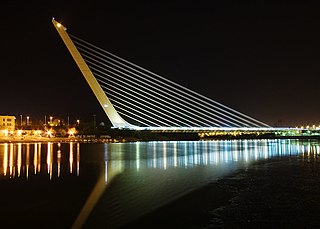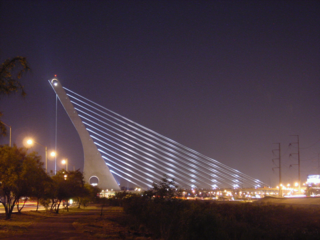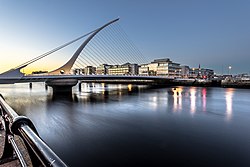
The River Liffey is a river in eastern Ireland that ultimately flows through the centre of Dublin to its mouth within Dublin Bay. Its major tributaries include the River Dodder, the River Poddle and the River Camac. The river supplies much of Dublin's water and supports a range of recreational activities.

Santiago Calatrava Valls is a Spanish architect, structural engineer, sculptor and painter, particularly known for his bridges supported by single leaning pylons, and his railway stations, stadiums, and museums, whose sculptural forms often resemble living organisms. His best-known works include the Olympic Sports Complex of Athens, the Milwaukee Art Museum, the Turning Torso tower in Malmö, Sweden, the World Trade Center Transportation Hub in New York City, the Auditorio de Tenerife in Santa Cruz de Tenerife, the Margaret Hunt Hill Bridge in Dallas, Texas, and his largest project, the City of Arts and Sciences and Opera House in his birthplace, Valencia. His architectural firm has offices in New York City, Doha, and Zürich.
The year 2001 in architecture involved some significant architectural events and new buildings.

The Sundial Bridge is a cantilever spar cable-stayed bridge for bicycles and pedestrians that spans the Sacramento River in Redding, California, United States and forms a large sundial. It was designed by Santiago Calatrava and completed in 2004 at a cost of US$23.5 million. The bridge has become iconic for Redding.

The Puente de la Mujer is a rotating footbridge for Dock 3 of the Puerto Madero commercial district of Buenos Aires, Argentina. It is of the cantilever spar cable-stayed bridge type and is also a swing bridge, but somewhat unusual in its asymmetrical arrangement. It has a single mast with cables suspending a portion of the bridge which rotates 90 degrees in order to allow water traffic to pass. When it swings to allow watercraft passage, the far end comes to a resting point on a stabilizing pylon.

The Alamillo Bridge is a structure in Seville, Andalucia (Spain), which spans the Canal de Alfonso XIII, allowing access to La Cartuja, a peninsula located between the canal and the Guadalquivir River. The bridge was constructed as part of infrastructure improvements for Expo 92, which was held on large banana farms on the island. Construction of the bridge began in 1989 and was completed in 1992 from a design by Santiago Calatrava.

The Millennium Bridge is a pedestrian bridge spanning the River Liffey in Dublin, Ireland, joining Eustace Street in Temple Bar to the north quays.

James Joyce Bridge is a road bridge spanning the River Liffey in Dublin, Ireland, joining the south quays to Blackhall Place on the north side.

Frank Sherwin Bridge is a road bridge spanning the River Liffey in Dublin, Ireland. It joins St. John's Road and the south quays from Heuston Station to Wolfe Tone Quay and Parkgate Street on the Northside.

Father Mathew Bridge is a road bridge spanning the River Liffey in Dublin, Ireland, which joins Merchants Quay to Church Street and the north quays. It occupies the approximate site of the original, and for many years the only, Bridge of Dublin, dating back to the 11th century.

A cantilever spar cable-stayed bridge is a modern variation of the cable-stayed bridge. This design has been pioneered by the structural engineer Santiago Calatrava in 1992 with the Puente del Alamillo in Seville, Spain. In two of his designs the force distribution does not depend solely upon the cantilever action of the spar (pylon); the angle of the spar away from the bridge and the weight distribution in the spar serve to reduce the overturning forces applied to the footing of the spar. In contrast, in his swinging Puente de la Mujer design (2002), the spar reaches toward the cable supported deck and is counterbalanced by a structural tail. In the Assut de l'Or Bridge (2008), the curved backward pylon is back-stayed to concrete counterweights.

The Zubizuri, also called the Campo Volantin Bridge or Puente del Campo Volantin, is a tied arch footbridge across the Nervion River in Bilbao, Spain. Designed by architect Santiago Calatrava, the bridge links the Campo Volantin right bank and Uribitarte left bank of the river.

The Clyde Arc is a road bridge spanning the River Clyde in Glasgow, Scotland, connecting Finnieston near the Clyde Auditorium and SEC with Pacific Quay and Glasgow Science Centre in Govan. Prominent features of the bridge are its innovative curved design, and that it crosses the river at an angle. The Arc is the first city centre traffic crossing over the river built since the Kingston Bridge was opened to traffic in 1970.

Puente de la Unidad or Viaducto de la Unidad is a cantilever spar cable-stayed bridge designed by Óscar Bulnes that crosses the Santa Catarina River and connects the cities of Monterrey and San Pedro Garza García in the Mexican state of Nuevo León. It is part of a circuit called "Circuito La Unidad", which would consist of the interconnection of a series of avenues.

The Chords Bridge, also called the Bridge of Strings or Jerusalem Light Rail Bridge, is a side-spar cable-stayed bridge in Jerusalem. The structure was designed by the Spanish architect and engineer Santiago Calatrava and is used by Jerusalem Light Rail's Red Line, which began service on August 19, 2011. Incorporated in the bridge is a glass-sided pedestrian bridge enabling pedestrians to cross from Kiryat Moshe to the Jerusalem Central Bus Station. The bridge, which cost about $70 million, was inaugurated on June 25, 2008.

The Northern Spire Bridge is a bridge over the River Wear in Sunderland, Tyne and Wear, England. The crossing opened to pedestrians on 28 August 2018, before opening to traffic the next day. A two span cable-stayed structure, construction began in May 2015, overseen by Farrans Construction and Victor Buyck Steel Construction.

The Assut de l'Or Bridge is a white single-pylon cable-stayed bridge in the City of Arts and Sciences in Valencia, Spain, designed by Valencian architect and civil engineer Santiago Calatrava and completed in December 2008. The name l'Assut de l'Or is Valencian for the Dam of the Gold and refers to a dam that was located nearby, although locally it is referred to as El Jamonero or Pont de l'Arpa, Spanish: Puente del Arpa. Calatrava called it the Serreria Bridge.

The Rosie Hackett Bridge is a road and tram bridge in Dublin, Ireland, which opened on 20 May 2014. Spanning the River Liffey and joining Marlborough Street to Hawkins Street, it is used solely by public transport, taxis, cyclists and pedestrians. It is 26 metres wide and 48 metres long, and is a single span, smooth concrete structure, with the underside of the bridge designed to be as high above the water as possible so that river traffic is not impeded. It was built to carry the extended Luas Green line, and was budgeted at €15 million. It is named for trade unionist Rosie Hackett (1893–1976).





















